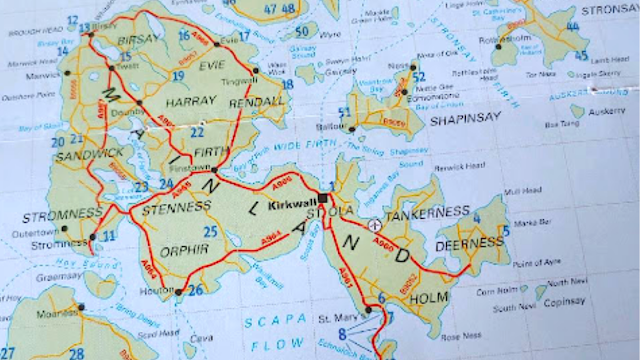A trip to the Orkney Islands Part 1 (20 miles north of the coast of Scotland)
Imagine yourself traveling from London to the northern tip of Scotland. The 8 hours train ride is very pleasant, often along the North Sea, other time through the English countryside, peaceful and green with cows and horses grazing around the farms.
Inverness is at the end of the line, an important town with
fancy and comfortable “Victorian” hotels welcoming you.
The next morning, you board a smaller train, called “The Far
North Line”, where the passengers talk to one another in a friendly way. The landscape is now different with spare farms,
cottages with thatched roofs, sheep grazing everywhere, beautiful scenery with
rocks and lakes (called lochs). The
route stops at Thurso, the most northerly train station in the British Isles.
Thurso is close to Scrabster and you will again change your
mode of transportation…. This time, it will be the “PO Scottish
Ferry “which will take you to Stromness, on the largest of the Orkneys. On the way, you pass “The Old Man of Hoy”, a
450 feet high sandstone rock on a basalt base… a famous landmark. 70 islands
form this interesting archipelago and only 20 are inhabited by 20,000 people.
They are a part of Scotland.
You now arrive on the mainland. You will need a ride to the capital, Kirkwall, a beautiful old town, where you will find the ruins of an old castle and Saint Magnus Cathedral, with red and yellow sandstone started in 1137. It took three centuries to complete and exhibits different stages: Romanesque, Traditional and Gothic. In 1486 the Cathedral was assigned to the inhabitants of Kirkwall and later became a part of the Church of Scotland.
The climate is rough. Rain and winds prevent large trees to
grow. Only bushes and small trees are found. The inhabitants use stones to
build their houses, adorning them with flowers.
Because stones were used instead of wood for centuries, beautifully
preserved prehistoric sites can still be admired all over the islands.
The Orkneys are a paradise for lovers of birds. You find
gulls, razor bills and colonies of puffins, settled in cavities in the rocks by
the sea, making a huge noise.
All the inhabited islands are connected by a service of
ferries, which are reliable, except on stormy days.
Further north, you will find the Shetland Islands, also a
part of Scotland, with fishing and farm industries.
If you don’t mind rain and wind, the Orkneys are for you. A
wild but quiet atmosphere will show you a rough but splendid nature and
beautiful skies.
















Very nice :-)
ReplyDeleteThanks.^^
DeleteWhat an interesting trip, not everybody knows about these northern islands.
ReplyDeleteThat's true. Thanks for sharing your comment!^^
Delete